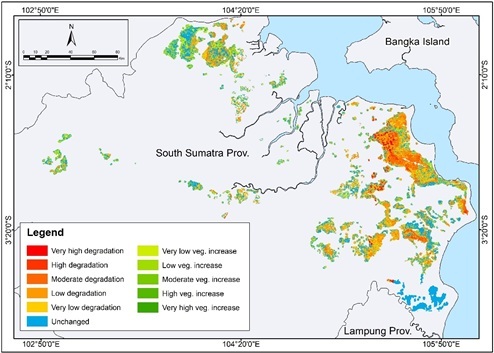Rapid Land Cover Change in The South Sumatera Peat Area Associated With 2015 Peat Fires
DOI:
https://doi.org/10.25299/jgeet.2022.7.1.6395Keywords:
Abstract Peat Fire, NDVI, Burned Area, DegradationAbstract
The peat fire events in Indonesia, particularly the South Sumatra area, changed the appearance of surface vegetation. The fires usually occur during the dry season from July to October. This study aims to evaluate land cover changes due to 2015’s peat fire in the South Sumatra peatlands. Remote sensing techniques using a Normalized Difference Vegetation Index (NDVI) method were used to identify the change of vegetation density in the study area. The results showed that 69% of the total South Sumatra peatland was burned due to the 2015 peat fire event. The level of vegetation density was considerably decreased by fire events. The degradation in the burned area was dominated by land cover class of ferns/shrub. The Peat fires during the observation period have a negative impact on the peat ecosystem, so improvements are needed in peatland management practices. Improvements need to be made in fire prevention and management practices, as well as restoration of burnt land.
Downloads
References
Agus, F., Henson, I., Sahardjo, B.H., Harris, N., van Noordwijk, M., Killeen, T., 2013. Review of emission factors for assessment of CO2 emission from land use change to oil palm in Southeast Asia 7–28.
Bharathkumar, L., Mohammed-Aslam, M.A., 2015. Crop Pattern Mapping of Tumkur Taluk Using NDVI Technique: A Remote Sensing and GIS Approach. Aquat. Procedia 4, 1397–1404.
Harrison, M.E., Page, S.E., Limin, S.H., 2009. The global impact of Indonesian forest fires. Biologist 56, 156–163.
Hooijer, Aljosja, Silvius, Marcel, Wösten, Henk, Page, Susan, Hooijer, A, Silvius, M, Wösten, H, Page, S, 2006. PEAT-CO2, Assessment of CO2 emissions from drained peatlands in SE Asia. Delft Hydraul. Rep. Q3943 36.
Jaenicke, J., W??sten, H., Budiman, A., Siegert, F., 2010. Planning hydrological restoration of peatlands in Indonesia to mitigate carbon dioxide emissions. Mitig. Adapt. Strateg. Glob. Chang. 15, 223–239.
Koplitz, S.N., Mickley, L.J., Marlier, M.E., Buonocore, J.J., Kim, P.S., Liu, T., Sulprizio, M.P., DeFries, R.S., Jacob, D.J., Schwartz, J., Pongsiri, M., Myers, S.S., 2016. Public health impacts of the severe haze in Equatorial Asia in September-October 2015: Demonstration of a new framework for informing fire management strategies to reduce downwind smoke exposure. Environ. Res. Lett. 11.
Marlier, Miriam E., Defries, R., Pennington, D., Nelson, E., Ordway, E.M., Lewis, J., Koplitz, S.N., Mickley, L.J., 2015a. Future fire emissions associated with projected land use change in Sumatra. Glob. Chang. Biol. 21, 345–362.
Marlier, Miriam E, DeFries, R.S., Kim, P.S., Gaveau, D.L.A., Koplitz, S.N., Jacob, D.J., Mickley, L.J., Margono, B.A., Myers, S.S., 2015. Regional air quality impacts of future fire emissions in Sumatra and Kalimantan. Environ. Res. Lett. 10, 054010.
Marlier, Miriam E., DeFries, R.S., Kim, P.S., Koplitz, S.N., Jacob, D.J., Mickley, L.J., Myers, S.S., 2015b. Fire emissions and regional air quality impacts from fires in oil palm, timber, and logging concessions in Indonesia. Environ. Res. Lett. 10.
Meneses-Tovar, C.L., 2011. NDVI as indicator of degradation. Unasylva 62, 39–46.
Miettinen, J., Hooijer, A., Wang, J., Shi, C., Liew, S.C., 2012a. Peatland degradation and conversion sequences and interrelations in Sumatra. Reg. Environ. Chang. 12, 729–737.
Miettinen, J., Shi, C., Liew, S.C., 2016. Land cover distribution in the peatlands of Peninsular Malaysia, Sumatra and Borneo in 2015 with changes since 1990. Glob. Ecol. Conserv. 6, 67–78.
Miettinen, J., Shi, C., Liew, S.C., 2012b. Two decades of destruction in Southeast Asia’s peat swamp forests. Front. Ecol. Environ. 10, 124–128.
Page, S.E., Hooijer, A., 2016. In the line of fire: the peatlands of Southeast Asia. Philos. Trans. R. Soc. B Biol. Sci. 371, 20150176.
Page, S.E., Rieley, J.O., Shotyk, W., Weiss, D., 1999. Interdependence of peat and vegetation in a tropical peat swamp forest. Philos. Trans. R. Soc. Lond. B. Biol. Sci. 354, 1885–1897.
Pagiola, S., 2000. Land Use Change in Indonesia. Environment Departement, World Bank
Putra, R., Sutriyono, E., Kadir, S., Iskandar, I., 2019. Understanding of fire distribution in the south. Int. J. GEOMATE 16, 146–151.
Sloan, S., Locatelli, B., Wooster, M.J., Gaveau, D.L.A., 2017. Fire activity in Borneo driven by industrial land conversion and drought during El Niño periods, 1982–2010. Glob. Environ. Chang. 47, 95–109.
Thorburn, C.C., Kull, C.A., 2015. Peatlands and plantations in Sumatra, Indonesia: Complex realities for resource governance, rural development and climate change mitigation. Asia Pac. Viewp. 56, 153–168.
Wahyunto, Ritung, S., Suparto, H. Subagjo, 2004. Map of Peatland Distribution Area and Carbon Content in Kalimantan.

Downloads
Published
Issue
Section
License
Copyright @2019. This is an open-access article distributed under the terms of the Creative Commons Attribution-ShareAlike 4.0 International License which permits unrestricted use, distribution, and reproduction in any medium. Copyrights of all materials published in JGEET are freely available without charge to users or / institution. Users are allowed to read, download, copy, distribute, search, or link to full-text articles in this journal without asking by giving appropriate credit, provide a link to the license, and indicate if changes were made. All of the remix, transform, or build upon the material must distribute the contributions under the same license as the original.










